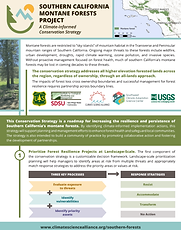
About the Project
By engaging partners across southern California, this project is advancing our collective understanding of the vulnerabilities and challenges facing montane forests and the opportunities and strategies for increasing forest resilience.
Learn about our project objectives and explore our resources below. For additional background information about the project, scroll down to Project Background.
PROJECT OBJECTIVES

Build a community of practice
Through partner engagement and collaboration, we have developed a common understanding among resource and fire managers, policy makers, the science community, Tribal partners, and other stakeholders regarding the threats to Southern California's montane forests and the benefits they provide as well as the strategies to minimize those threats.

Build a climate-adapted strategy
Our project team has worked with this community of practice to:
I. Develop a Forest Conservation Strategy
This climate-adapted strategy is a roadmap for sustaining montane forests in Southern California;
II. Identify Implementation Actions
The strategy is already informing planning and management efforts to enhance forest health and resilience;
III. Promote Collaboration
To accomplish the implementation actions identified in the strategy, we are promoting ongoing collaborative action and fostering the development of partnerships to improve forest resilience.
PROJECT RESOURCES

Project Background
Southern California’s montane forests are unique and fundamental to the region.
Montane forests (forests >5,000 ft elevation) are restricted to "sky islands" of mountain habitat found in the Transverse and Peninsular mountain ranges of Southern California, with most of the montane forest area found in the San Jacinto, San Bernardino, and San Gabriel Mountains and extending to smaller areas on mountains further north and south. As in the Sierra Nevada, southern California montane forests are dominated by a mix of conifers (mostly pines, firs, and incense cedar) and hardwood (mostly oak) species.

Map depicting extent of montane forests in southern California in relation to mountain ranges.
Montane forests protect the upper watersheds of all of the region's major rivers and provide important ecosystem services, including carbon sequestration, soil conservation, erosion and sedimentation reduction, plant and wildlife habitat and migration corridors, shading and cooling of surface waters, recreational opportunities, and aesthetic and spiritual connections. These watersheds also provide about 40% of the water used for human, agricultural, and industrial purposes in Southern California.
Carbon
Sequestration
Erosion & Sedimentation
Reduction
Shading & Cooling of
Surface Waters
Aesthetic & Spiritual
Connections
Biodiversity &
Habitat Conservation
Plant/Wildlife Habitat &
Migration Corridors
Recreational
Opportunities
Watershed
Protection
These forests are under threat from a suite of rapidly intensifying stressors and disturbances, including many that have strong climate connections.
The region is characterized by high habitat diversity, strong ecological and climatic gradients, and a suite of active processes such as wildfires, earthquakes, mountain uplift, floods, and debris flows. In addition, the region supports a large and growing human population (25 million people, nearly 8% of the US total) which poses a threat to one of the country’s most biodiverse regions, affecting plants and animal populations, their habitats, and the ecosystem services they provide. Sensitive, threatened, and endangered state and federal species number in the hundreds. Specific threats include the most rapid climate warming in the US; one of the most variable precipitation regimes in the US; persistent, long-term droughts; the highest ozone pollution levels in the nation; increasingly large and severe wildfires; massive levels of habitat loss due to urban and suburban expansion; and an expanding list of damaging invasive species.
Rapid
Warming
Variable
Precipitation Regimes
Persistent,
Long-Term Droughts
Ozone
Pollution

Increasingly Large
& Severe Wildfires
Habitat
Loss
Invasive
Species
Since the turn of the century, the status of montane forests in southern California has markedly declined. Climate warming has accelerated; ozone pollution has continued to exceed national standards; two major drought periods and associated bark beetle outbreaks have killed tens-of-millions of trees; large and severe wildfires have burned large areas of forest; and new invasive species are posing new threats (e.g. the Gold-Spotted Oak Borer).
Overall, this project looks to overcome the challenges of managing sustainable montane forests in southern California by creating a coordinated strategic conservation vision and action plan shared across agencies and stakeholders.



.png)



